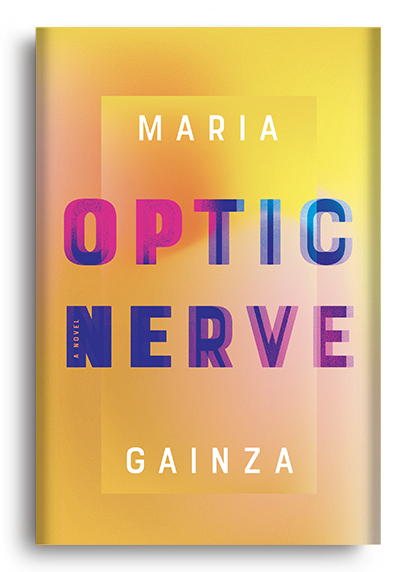Optic Nerve A Novel by María Gainza
Reviews
By Wilson McBee
Any good critic knows how useful the deft deployment of a personal anecdote can be. It humanizes the writer, situates the issue at hand in the real world, and allows for a passage of vivid, scenic writing that can provide a counterweight to the analytical prose. The problem comes when you have a moment from your past that is almost, but not quite, relevant—if only a few of the details were different, one thinks, it would be perfect—and you have to leave it out. Optic Nerve, the debut novel by Argentinian art critic María Gainza, could have grown out of this specific problem, given that it presents a compelling solution to it. Rather than confining herself to the completely factual, Gainza uses the techniques of fiction to amplify her ruminations on painting in the nineteenth and early twentieth centuries.
The narrator of Optic Nerve and Gainza have a lot in common. They have the same first name, María, and they both live in Buenos Aires and are involved in the art world. These and other biographical connections have led some to tag the book as autofiction, which is fair, I guess, but it’s important to note that Gainza’s ambivalence toward the conventions of character and plot is even more pronounced than that of writers like Ben Lerner and Rachel Cusk—as boundary-pushing as they might be. Optic Nerve is divided into chapters in which Gainza threads the story of one or two artists with scenes and reflections from the protagonist’s life. Besides María, only a few characters appear in multiple chapters, and there isn’t a major story arc that ties the sections together. Similarly, Gainza rarely refers to art-historical moments or observations from earlier chapters. Given that its chapters are so varied and self-contained, Optic Nerve might be better categorized as a collection of short stories or fictional essays than as a novel.
The driving force behind Optic Nerve’s roving, elusive structure is Gainza’s uniquely enchanting voice. She is masterful at weaving together scenes from the life of her protagonist and moments from art history such that the correspondences are both explicit and subtle. For example, the chapter “Lightning at Sea” begins with María watching her friends surf, then moves into a discussion of Gustave Courbet’s maritime paintings; after a brief aside about the movie Point Break, the section concludes with a stirringly beautiful passage about María’s cousin, an obsessive swimmer who succumbs to mental illness. While on the surface the chapter maps out a fairly straightforward visual narrative focusing on the ocean, at its core it is about the ways that nature can inspire us to mania. Gainza is at her best when using fictional moments to illuminate art. In other highlight chapters in this vein, meditations on disability and the experience of outsiders speak to the paintings of Toulouse-Lautrec, and a story about Argentina’s lingering class divisions provides a new angle on the hunting scenes of Alfred Dreux.
Gainza is less adept in chapters weighted more heavily toward the purely fictional. Aside from María herself, the characters she creates too often fail to cohere. The chapter “Separate Ways” pairs a string of incidents involving María and her childhood best friend, Alexia, with a discussion of the Japanese painter Tsuguharu Foujita. Alexia moves across the world—her vagabondism ties her to Foujita—and the two friends grow apart. María struggles with losing her friend, but this loss doesn’t fully resonate with the reader because Alexia never becomes more than an amalgamation of exotic anecdotes. If one comes to Optic Nerve looking for the typical hallmarks of good fiction—complex, surprising characters and moments of dramatic tension—then that expectation will largely be disappointed. Rather, Gainza’s gift emerges in how she uses the techniques of the novelist to advance her analysis of visual art.
Late in Optic Nerve, María asks, “isn’t all artwork—all decent art—a mirror?” Most readers will understand this question as merely rhetorical, as Gainza has spent the bulk of the book proving how art can be a springboard to understanding the self, and vice versa. In a challenge to the critic’s questionable claims to objectivity, Optic Nerve reminds us that there is no purely objective viewer, or reader, and that our own personal histories are always bound up in our experience of art. Another implication of her hybrid form is the notion that sometimes the most satisfying way to respond to art is by creating more art. This shouldn’t be taken as a knock on criticism so much as an invitation for critics to rise to the level of their subjects. Optic Nerve shows that you can novelize about painting in the same that way one can dance about architecture, despite the oft-quoted crack, and produce something worthwhile. And perhaps Optic Nerve is best appreciated not as a criticism-inflected novel but as a fiction-inflected work of criticism. Calling Optic Nerve a work of criticism rather than a novel would probably garner Gainza less attention—and it could be the case that Gainza’s own mislabeling of her book led her to include its clumsiest parts, namely, the purely fictional ones—but to my mind it is a better encapsulation of her tremendously exciting achievement.
More Reviews

